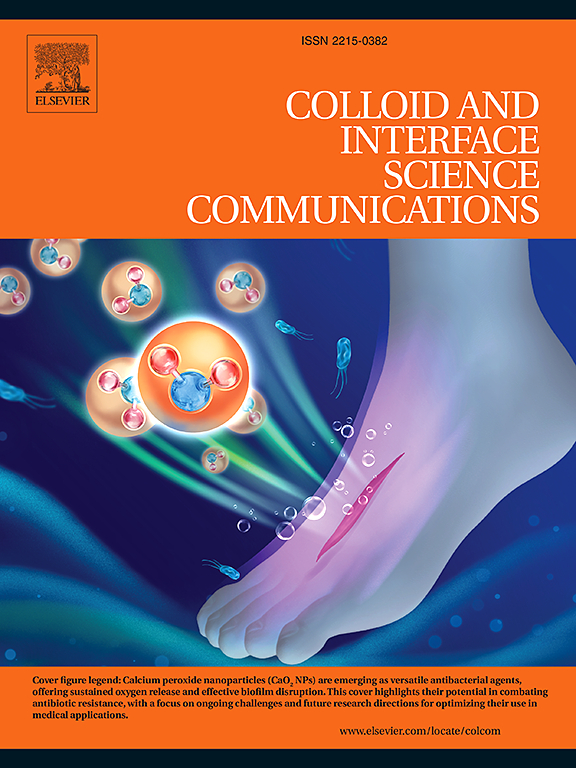用于增强光热抗菌活性的氧化铁超颗粒的分层组装
IF 4.7
3区 材料科学
Q2 CHEMISTRY, PHYSICAL
引用次数: 0
摘要
细菌感染,特别是由耐药菌株引起的细菌感染,对全球健康构成重大威胁。利用氧化铁纳米颗粒进行光热治疗在抗菌治疗中显示出前景,但其使用受到毒性和纳米颗粒团聚的限制。本研究提出了一种可扩展的喷雾干燥方法来合成氧化铁超颗粒,旨在提高抗菌效果,同时最小化细胞毒性。与纳米颗粒相比,氧化铁超颗粒表现出优异的过氧化物酶样活性,通过增加的活性位点产生羟基自由基。在近红外激光照射(1064 nm)下,它们对大肠杆菌和金黄色葡萄球菌表现出显著的抗菌活性,抗菌率分别达到77%和80%,优于纳米颗粒(25%和12%)。其独特的结构,具有较大的直径,粗糙的表面和内部孔隙,有助于提高抗菌性能。此外,氧化铁超颗粒在人真皮成纤维细胞中保持了较高的细胞活力,证实了其生物相容性。这些超粒子为广谱抗菌应用提供了一种很有前途的方法,而不会损害宿主细胞的活力。本文章由计算机程序翻译,如有差异,请以英文原文为准。

Hierarchical assembly of iron-oxide supraparticles for enhanced photothermal antibacterial activity
Bacterial infections, particularly those caused by drug-resistant strains, pose a significant global health threat. Photothermal therapy using iron-oxide nanoparticles shows promise in antibacterial treatments, but their use is limited by toxicity and nanoparticle agglomeration. This study presents a scalable spray-drying method to synthesize iron-oxide supraparticles, designed to enhance antibacterial efficacy while minimizing cytotoxicity. The iron-oxide supraparticles exhibited superior peroxidase-like activity compared to their nanoparticles, generating hydroxyl radicals through increased active sites. They demonstrated significant antibacterial activity against Escherichia coli and Staphylococcus aureus under near-infrared laser irradiation (1064 nm), achieving antibacterial rates of 77 % and 80 %, respectively, outperforming nanoparticles (25 % and 12 %). Their unique structure, with a larger diameter, rough surface, and internal porosity, contributed to improved antibacterial performance. Additionally, iron-oxide supraparticles maintained high cell viability in human dermal fibroblasts, confirming their biocompatibility. These supraparticles offer a promising approach for broad-spectrum antimicrobial applications without compromising host-cell viability.
求助全文
通过发布文献求助,成功后即可免费获取论文全文。
去求助
来源期刊

Colloid and Interface Science Communications
Materials Science-Materials Chemistry
CiteScore
9.40
自引率
6.70%
发文量
125
审稿时长
43 days
期刊介绍:
Colloid and Interface Science Communications provides a forum for the highest visibility and rapid publication of short initial reports on new fundamental concepts, research findings, and topical applications at the forefront of the increasingly interdisciplinary area of colloid and interface science.
 求助内容:
求助内容: 应助结果提醒方式:
应助结果提醒方式:


